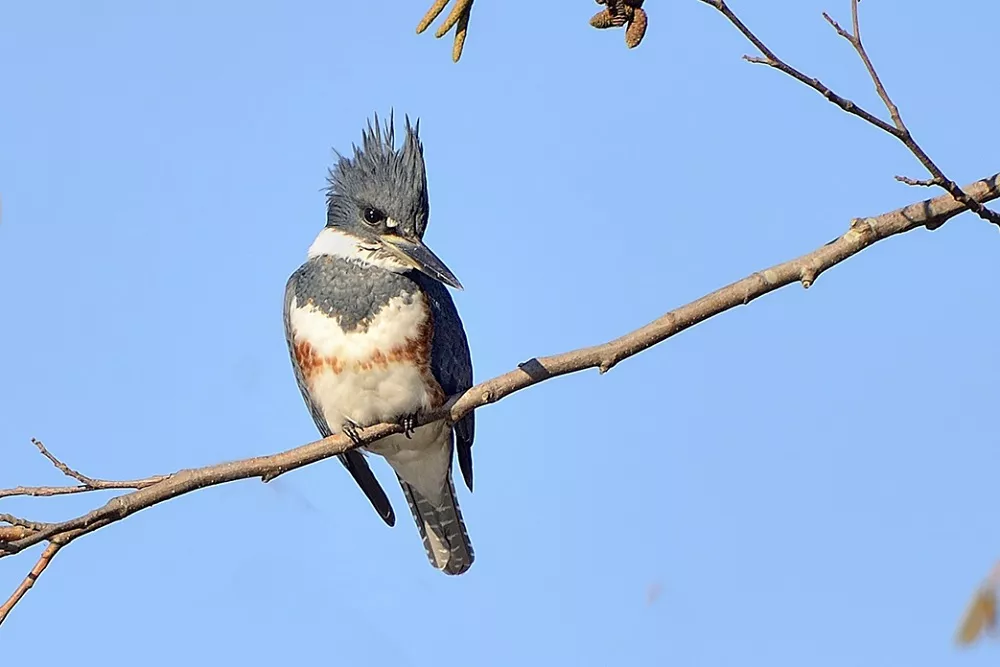The Belted Kingfisher (Megaceryle alcyon) is a fascinating bird species that thrives in the diverse wetland habitats of North America. With its distinctive appearance, remarkable hunting techniques, and unique adaptations, the Belted Kingfisher has captured the attention and admiration of bird enthusiasts and researchers alike. In this article, we delve into the intriguing world of the Belted Kingfisher, exploring its physical characteristics, behavior, and ecological significance.
Physical Characteristics of the Belted Kingfisher
The Belted Kingfisher is a medium-sized bird, measuring between 28 and 35 centimeters in length, with a wingspan of around 48 to 58 centimeters. It has a unique appearance with a large head, shaggy crest, and a long, pointed bill. Males can be distinguished from females by their slate-blue chest band, while females have a rust-colored band on their bellies. Both males and females have a blue-gray back and wings, with white underparts.
Belted Kingfishers are well-adapted for diving and swimming as they have webbed feet and a streamlined body. Their long, dagger-like bill is specially designed to help them catch fish. They use their keen eyesight to spot prey from above and then plunge straight into the water, capturing their prey with incredible speed and precision.
Habitat and Distribution
Belted Kingfishers are primarily found in North America, ranging from Alaska and Canada down to Mexico, with some individuals venturing as far south as Central America during migration. They are commonly associated with freshwater and saltwater habitats, including rivers, streams, lakes, marshes, coastal areas, and even man-made reservoirs. These adaptable birds have the remarkable ability to thrive in diverse environments as long as suitable nesting sites and an abundant food supply are available.
Behavior and Hunting Techniques
Renowned for their exceptional fishing skills, Belted Kingfishers employ a distinctive hunting strategy. They perch on tree branches, utility wires, or other elevated vantage points overlooking the water, keenly scanning the surroundings for potential prey. Once a target is spotted, the kingfisher dives headfirst into the water with remarkable speed and precision, using its strong wings to propel itself underwater. Equipped with specialized eyes that can adjust for the difference in refraction between air and water, the kingfisher can accurately judge the position of its prey. Upon capturing a fish, it returns to a perch to consume it or may even consume it while still in flight.
Breeding and Nesting
Belted Kingfishers are monogamous birds that form pair bonds during the breeding season. Males attract females by performing courtship displays, including flying back and forth while calling loudly. Once a pair bond has been established, they begin to excavate a nesting burrow into the banks of a river or stream.
The nesting burrow is usually located high above the water, providing protection from flooding. The entrance to the burrow is about 8-10 cm in diameter, leading to a chamber that can be up to 60 cm deep. The female lays a clutch of 5-8 white eggs that are incubated by both parents for about 3-4 weeks.
Diet
Belted Kingfishers diet mainly consists of fish, but they also feed on crustaceans, amphibians, reptiles, insects, small mammals, and occasionally other birds. Belted Kingfishers have a unique feeding technique where they hover over the water and then plunge headfirst into the water to catch their prey. They can dive up to 6 meters deep and remain underwater for up to 30 seconds.
Vocalizations
The Belted Kingfisher is known for its distinctive and loud rattling call, which serves various purposes. Males use vocalizations to establish and defend their territories, often engaging in high-flying displays accompanied by their calls. Both males and females produce calls during courtship rituals and to communicate with their mates. In addition, vocalizations are used to warn off potential intruders and predators.
Conservation Status
Belted Kingfishers are not considered to be threatened or endangered, with a stable population estimated at around 2 million individuals. However, they face various threats, including habitat loss due to human development and pollution of waterways. Conservation efforts such as wetland restoration and water quality improvement can help protect Belted Kingfisher populations.
Conclusion
The Belted Kingfisher is a remarkable bird that exemplifies nature’s ingenuity and adaptability. With its striking appearance, exceptional fishing skills, and significant ecological role, the kingfisher continues to captivate the imagination of bird enthusiasts and researchers alike. By understanding and appreciating the unique characteristics and behaviors of the Belted Kingfisher, we can foster a greater appreciation for the intricate wonders of the natural world and work towards conserving its habitats for future generations.
Related Topics:
- Where Do Belted Kingfishers Live?
- How Long Does a Belted Kingfisher Live?
- What Does a Belted Kingfisher Sound Like?


 Facebook
Facebook  Instagram
Instagram  Youtube
Youtube 